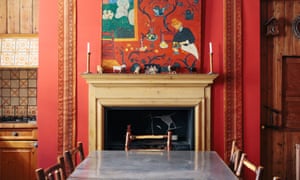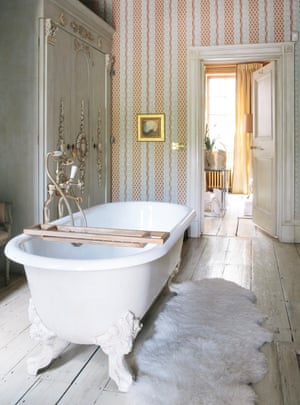Some houses call you… You feel drawn to their layers of history,” says Kate Braine. Her 18th-century townhouse in Chelsea is an atmospheric case in point. Narrow passageways lead to panelled rooms where marble fireplaces are illuminated by lamplight. Gappy floorboards are split with the fissures of three centuries; vertiginous stairs plunge towards the dark basement kitchen. Sometimes, says Braine, she can hear the spectral “twangings” of the ghost that flits benignly through the grid of stucco-fronted houses bordered by the inky wash of the Thames.
Braine, a ceramicist whose fantastical forms spring from the “accidents and surprises” of experimentation, feels particularly at home here because the area has a history of innovation in design and art. From her roof terrace she can see where William de Morgan, the 19th-century potter renowned for wares adorned with fantastical beasts in lustrous glazes, had his workshop on the corner. A few doors down Josiah Wedgwood set up his decorating studio, luring other artists such as Dante Gabriel Rossetti and James McNeill Whistler, who turned this quiet backwater into a busy bohemia of studios and factories.

At some point in the 19th century, an artist also lived in Braine’s house and built the double-height studio at the back. Once pungent with turpentine and linseed oil, it is now a grand sitting room, the Edwardian coffered ceiling and parquet floors untouched. “Some friends say it’s the sort of room their grandparents might have had,” says Braine, who has lived here for 20 years with her two children. She added the salvaged William III fireplace (the house has 11 grates), as well as the suite of Bergère furniture inherited from her parents. A small, whimsical table is by the Italian designer Carlo Bugatti (father of the car-builder Ettore). A set of antique lamps came from Venice, while the fresco-effect walls are a recent addition. “It reminds me of a palazzo somewhere in northern Italy,” she says.
By coincidence, Braine’s predecessor was a “chic” Italian with flamboyant tastes. She installed the panelling and painted the floors to mimic inlaid wood. Over the years, Braine has tweaked the decoration “as I find things that appeal to my imagination”. A threadbare 1930s stair runner, an auction buy, snakes up to the top floor. In the bathroom, an armoire from France inspired the decorative cupboards, painted white to match the squeaky floorboards. Braine designed the round window that brings light to the top floors, where a friend crouched under the eaves to paint the nursery mural of camels, cobras and exotica. “The children have grown out of it, but I won’t change it.”

Echoing Braine’s tactile pottery, drenched in glazes of coral or azure, this is a house of contrasting surfaces and moods. One moment you are swishing through beaded curtains, the next reaching out to feel a wall covered in bamboo or a smooth plaster effect. Another friend, the Swiss designer Christophe Gollut, suggested Braine cover the bedroom walls with fabric; the paisley motif reminds her of shawls favoured by the Pre-Raphaelites. In the kitchen, the cue for the gallery-red walls was the fake “but painterly” Matisse which she brought home “rolled up in a suitcase” from Thailand. On the ground floor, the malachite-green wallpaper is a foil for ancestral-looking paintings, like Sir Henry Gilbert’s 19th-century portrait of Henry IV, snapped up at auction in Lille “and hauled back on the train”.
Like those of her former bohemian neighbours, Braine’s artistic career has spanned different media. She originally studied art and sculpture at City & Guilds, and went on to specialise in portraiture. The filmmaker Sam Wanamaker commissioned her to make the portrait of William Shakespeare for the Globe theatre, which perches on a plinth downstairs. Braine once spent months “stalking” Francis Bacon to get a true likeness for a bust that ended up in the artist’s Soho drinking den, the Colony Room Club.
Pottery has been her “addiction” for 20 years. “A day without making a pot is a day wasted,” she says. Braine works in an old Turkish bathhouse in the garden, where a “graveyard” flower bed is studded with shards of her broken pottery. Childhood nightmares of “Grimm’s fairytales, Peter and the Wolf and dark forests at night” seep into her triffid-like forms. She loves the physicality of pottery, “slashing and cutting” clay into waving tendrils: “I like pushing clay to the limits of its breakability, which is why some of it ends up in the flower bed.”
Until now, Braine has only sold her work to friends and family, but this month she holds her first solo show, at home. Tendril is the Night will bring another “phantasmagorical” presence to this charismatic house.
Tendril is the Night, 27-30 June and then by arrangement, 20 Cheyne Row, London SW3 ([email protected])




































